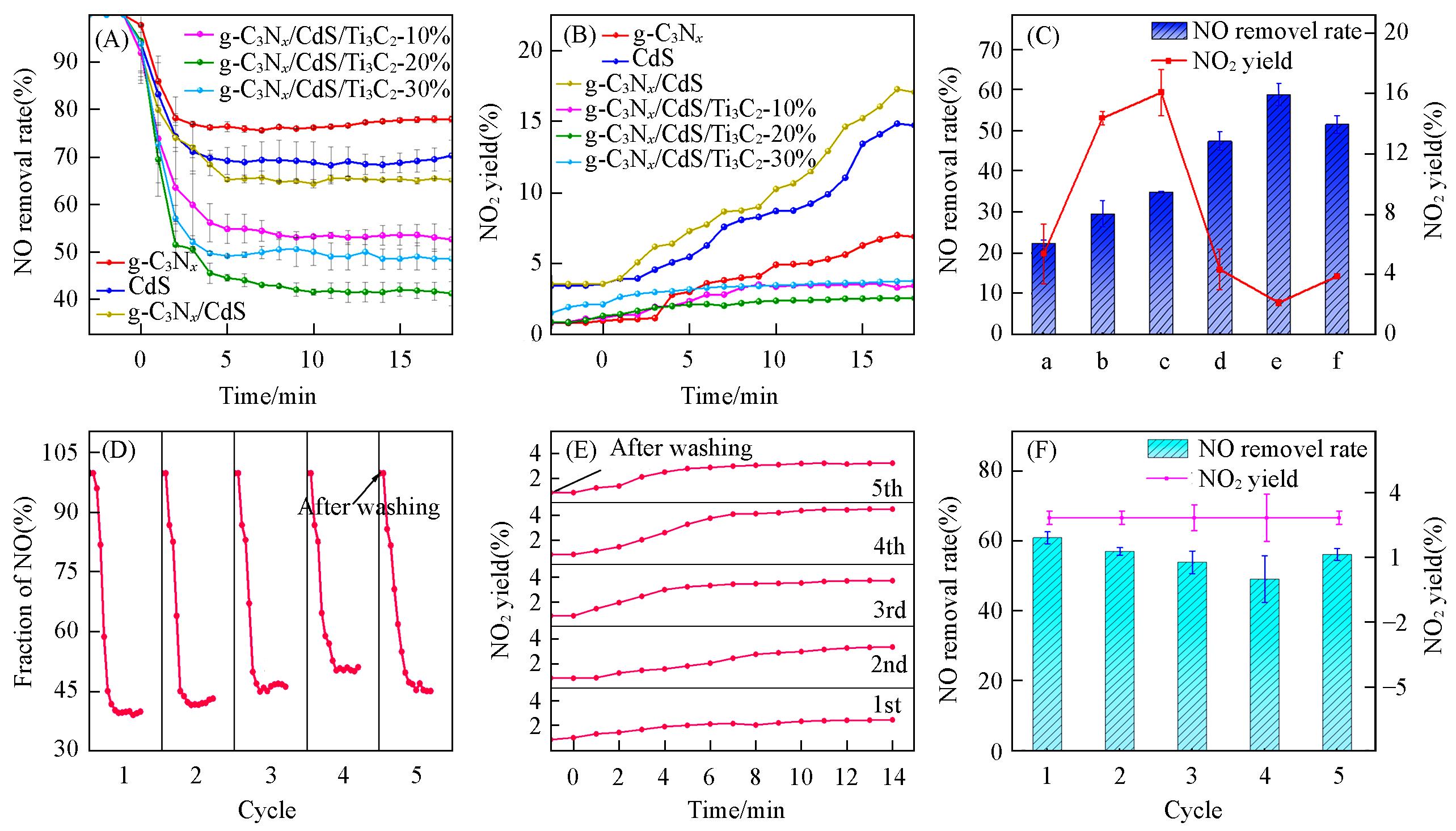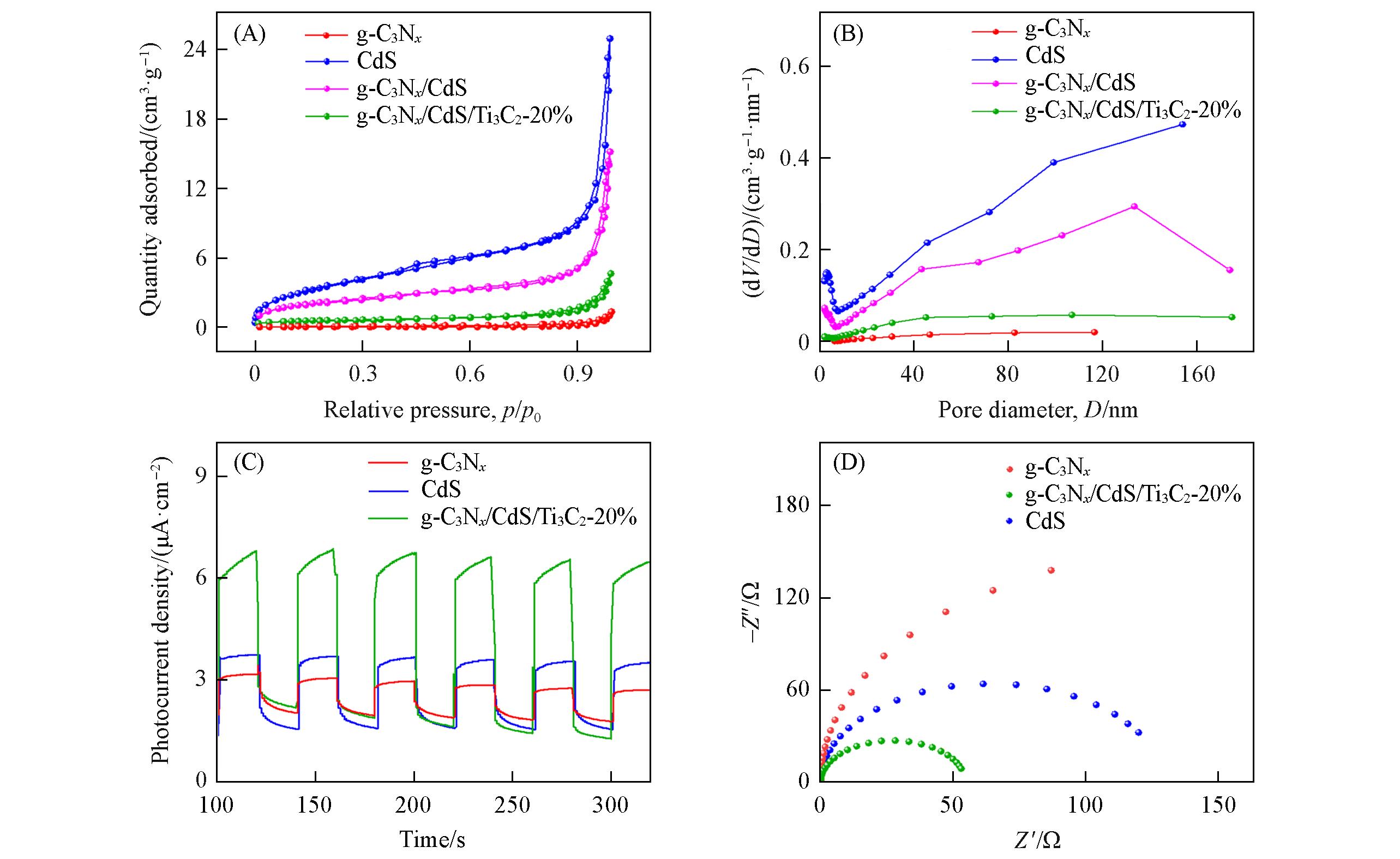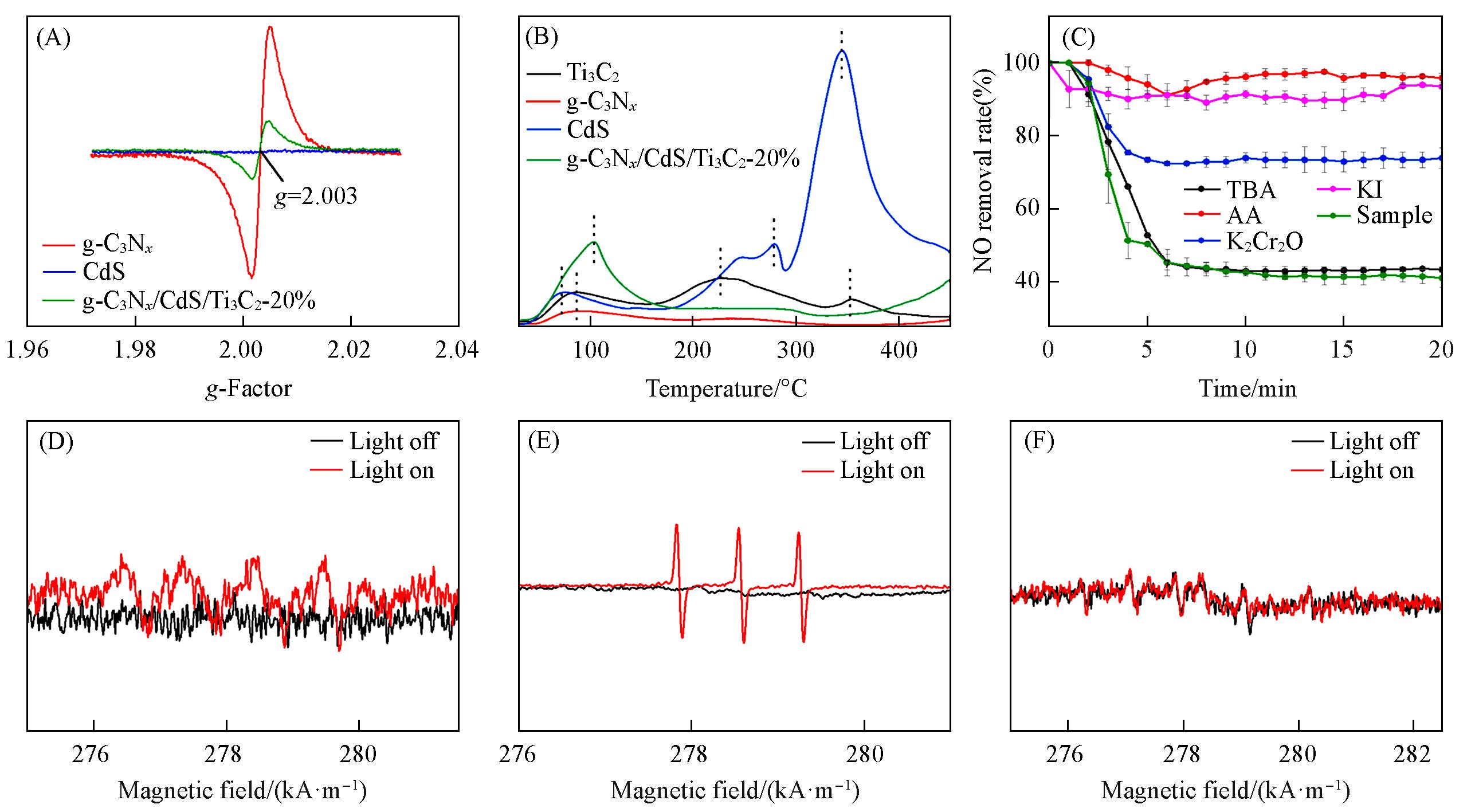

高等学校化学学报 ›› 2025, Vol. 46 ›› Issue (4): 20240488.doi: 10.7503/cjcu20240488
收稿日期:2024-10-29
出版日期:2025-04-10
发布日期:2025-01-03
通讯作者:
章柯,王传义
E-mail:kezhang@sust.edu.cn;wangchuanyi@sust.edu.cn
基金资助:
KANG Sha, ZHANG Ke( ), WEI Yajing, WANG Chuanyi(
), WEI Yajing, WANG Chuanyi( )
)
Received:2024-10-29
Online:2025-04-10
Published:2025-01-03
Contact:
ZHANG Ke, WANG Chuanyi
E-mail:kezhang@sust.edu.cn;wangchuanyi@sust.edu.cn
Supported by:摘要:
采用简单的溶剂热法合成了一系列具有N空位的g-C3N5/CdS/Ti3C2复合光催化剂. 通过缺陷工程和异质结的协同作用, 所设计的最佳比例g-C3N x /CdS/Ti3C2复合材料的光催化性能分别是g-C3N x 和CdS的2.7和2.4倍. 由于光吸收率的提高和界面电荷迁移的改善, 在可见光照射下, 10 min内g-C3N x /CdS/Ti3C2对流动反应器内的NO去除率达到60.21%, NO2的生成率仅为2.08%. 通过电子顺磁共振(EPR)和捕获实验分析了活性物种并推断出光生载流子的迁移途径. 此外, 通过原位漫反射傅里叶变换红外光谱(in-situ DRIFTS)进一步揭示了g-C3N x /CdS/Ti3C2体系光催化去除NO的机理. 研究结果为利用空位工程和异质结构的协同作用有效去除NO提供了新的思路和实验依据.
中图分类号:
TrendMD:
康莎, 章柯, 卫亚静, 王传义. N缺陷g-C3N5/CdS/Ti3C2异质结光催化剂的制备及高效去除NO性能. 高等学校化学学报, 2025, 46(4): 20240488.
KANG Sha, ZHANG Ke, WEI Yajing, WANG Chuanyi. In⁃situ Construction of N-defective g-C3N5/CdS/Ti3C2 Schottky Junction for High-efficiency Photocatalytic NO Removal. Chem. J. Chinese Universities, 2025, 46(4): 20240488.

Fig.1 Removal rate of nitrogen monoxide(A) and generation rate of nitrogen dioxide of synthesized samples(B), comparison of catalytic performance of synthesized samples(C), photocatalytic cycle test(D) and generation rate of nitrogen dioxide in the cycling test(E) and comparison of cycling performance of synthesized samples(F)(C) a. g-C3N x; b. CdS; c. g-C3N x /CdS; d. g-C3N x /CdS/Ti3C2-10%; e. g-C3N x /CdS/Ti3C2-20%; f. g-C3N x /CdS/Ti3C2-30%.(D)—(F) g-C3N x /CdS/Ti3C2-20%.

Fig.6 Nitrogen adsorption⁃desorption isotherms(A), pore diameter diagram(B), transient responses of photocurrent(C) and electrochemical impedance spectra(D) of the prepared catalysts
| Sample | SBET/(m2·g‒1) | Pore volume/(cm3·g‒1) | Pore size/nm |
|---|---|---|---|
| g⁃C3N x | 1.49 | 0.02 | 54.48 |
| CdS | 21.52 | 0.07 | 13.40 |
| g⁃C3N x /CdS | 81.97 | 0.23 | 11.46 |
| g⁃C3N x /CdS/Ti3C2⁃20% | 135.52 | 0.39 | 11.39 |
Table 1 Texture properties of g-C3N x, CdS, g-C3N x /CdS and g-C3N x /CdS/Ti3C2-20%
| Sample | SBET/(m2·g‒1) | Pore volume/(cm3·g‒1) | Pore size/nm |
|---|---|---|---|
| g⁃C3N x | 1.49 | 0.02 | 54.48 |
| CdS | 21.52 | 0.07 | 13.40 |
| g⁃C3N x /CdS | 81.97 | 0.23 | 11.46 |
| g⁃C3N x /CdS/Ti3C2⁃20% | 135.52 | 0.39 | 11.39 |
| Catalyst | A1 | τ1/ns | A2 | τ2/ns | Τavg/ns |
|---|---|---|---|---|---|
| g⁃C3N x | 0.296 | 1.56 | 0.024 | 9.73 | 4.30 |
| CdS | 0.099 | 1.19 | 0.025 | 29.99 | 26.08 |
| g⁃C3N x /CdS/Ti3C2⁃20% | 0.064 | 2.32 | 0.030 | 33.65 | 33.20 |
Table 2 Kinetics parameters of emission decay of g-C3N x, CdS and g-C3N x /CdS/Ti3C2-20%
| Catalyst | A1 | τ1/ns | A2 | τ2/ns | Τavg/ns |
|---|---|---|---|---|---|
| g⁃C3N x | 0.296 | 1.56 | 0.024 | 9.73 | 4.30 |
| CdS | 0.099 | 1.19 | 0.025 | 29.99 | 26.08 |
| g⁃C3N x /CdS/Ti3C2⁃20% | 0.064 | 2.32 | 0.030 | 33.65 | 33.20 |

Fig.9 EPR spectra(A) and O2⁃TPD plots of different samples(B), and capture experiment results(C), EPR spectra of •O2‒ (D), 1O2(E), •OH(F) of g⁃C3N x /CdS/Ti3C2⁃20%
| 24 | Chen Y. L., Liu X. Q., Hou L., Guo X. R., Fu R. W, Sun J. M., Chem. Eng. J., 2020, 383, 123132 |
| 25 | Vadivel S., Hariganesh S., Paul B., Mamba G., Puviarasu P., Colloids Surf. A, 2020, 592, 124583 |
| 26 | Kumar P., Vahidzadeh E., Thakur U. K., Kar P., Alam K. M., Goswami A., Mahdi N., Cui K., Bernard G. M., Michaelis V. K., Shankar K., J. Am. Chem. Soc., 2019, 141(13), 5415—5436 |
| 27 | Xiao R., Zhao C. X., Zou Z. Y., Chen Z. P., Tian L., Xu H. T., Tang H., Liu Q. Q., Lin Z. X., Yang X. F., Appl. Catal. B, 2020, 268, 118382 |
| 28 | Xin Y., Zhu Q. H., Gao T., Li X. M., Zhang W., Wang H., Ji D. H., Huang Y., Padervand M., Yu F., Wang C. Y., Appl. Catal. B, 2023, 324, 122238 |
| 29 | Dai W. R., Zhang S., Shang H., Xiao S. N., Tian Z. L., Fan W. B., Chen X. L., Wang S. K., Chen W., Zhang D. Q., Adv. Funct. Mater., 2023, 34(4), 2309426 |
| 30 | Zhang J. L., Li Z., Liu B., Chen M. S., Zhou Y. T., Zhu M. S., Appl. Catal. B, 2023, 328, 122522 |
| 31 | Li X. M., Dong Q. B., Li F., Zhu Q. H., Tian Q. Y., Tian L., Zhu Y. Y., Pan B., Padervand M., Wang C. Y., Appl. Catal. B, 2024, 340, 123238 |
| 32 | Wu H. Z., Yuan C. W., Chen R. M., Wang J. D., Dong F., Li J. Y., Sun Y. J., ACS Appl. Mater. Interfaces, 2020, 12(39), 43741—43749 |
| 33 | Gao T., Zhang K., Zhu Q. H., Tian Q. Y., Wang H., Zhang W., Liang J. Y. S., Lin J. Q., Allam A. A., Ajarem J. S., Robertson P. K. J., Wang C. Y., Catalysts, 2022, 12(11), 1455 |
| 34 | Shang H., Jia H. B., Zhang W. B., Li S. J., Wang Q., Yang Q. Y., Zhang C., Shi Y. X., Wang Y. J., Li P. P., He Y. C., Xiao S. N., Wang D., Zhang D. Q., Environ. Sci. Technol., 2023, 57(48), 20400—20409 |
| 35 | Li Y. H., Gu M. L., Zhang M., Zhang X. M., Lv K. L., Liu Y. Q., Ho W. K., Dong F., Chem. Eng. J., 2020, 389, 124421 |
| 1 | Gao T., Lin J. Q., Zhang K., Padervand M., Zhang Y. F., Zhang W., Shi M. L., Wang C. Y., Processes, 2023, 11(1), 115 |
| 2 | Nguyen V. H., Nguyen B. S., Huang C. W., Le T. T., Nguyen C. C., Nhi Le T. T., Heo D., Ly Q. V., Trinh Q. T., Shokouhimehr M., Xia C. L., Lam S. S., Vo D. V. N., Kim S. Y., Le Q. V., J. Cleaner Prod., 2020, 270, 121912 |
| 3 | Todorova N., Giannakopoulou T., Pomoni K., Yu J. G., Vaimakis T., Trapalis C., Catal. Today, 2015, 252, 41—46 |
| 4 | Ballari M. M., Hunger M., Hüsken G., Brouwers H. J. H., Appl. Catal. B, 2010, 95(3/4), 245—254 |
| 5 | Ai Z., Zhang K., Chang B., Shao Y. L., Zhang L., Wu Y. Z., Hao X. P., Chem. Eng. J., 2020, 383, 123130 |
| 6 | Feng C., Chen Z. Y., Jing J. P., Sun M. M., Tian J., Lu G. Y., Ma L., Li X. B., Hou J., J. Mater. Sci. Technol., 2021, 80, 75—83 |
| 7 | Sun B. T., Qiu P. Y., Liang Z. Q., Xue Y. J., Zhang X. L., Yang L., Cui H. Z., Tian J., Chem. Eng. J., 2021, 406, 127177 |
| 8 | Tao J. N., Wang M. Y., Liu G. W., Liu Q. Q., Lu L., Wan N., Tang H., Qiao G. J., J. Adv. Ceram., 2022, 11(7), 1117—1130 |
| 9 | Zhang K., Wei Y. J., Xie L. H., Kang S., Li F., Wang C. Y., Chin. Chem. Lett., 2025, 36(3), 110086 |
| 10 | Saeed A., Chen W., Shah A. H., Zhang Y. Y., Mehmood I., Liu Y. L., J. CO2 Util., 2021, 47, 101501 |
| 11 | Yu K., Huang H. B., Zeng X. Y., Xu J. Y., Yu X. T., Liu H. X., Cao H. L., Lü J., Cao R., Chem. Commun., 2020, 56(56), 7765—7768 |
| 12 | Huang H. B., Fang Z. B., Yu K., Lü J., Cao R., J. Mater. Chem. A, 2020, 8(7), 3882—3891 |
| 13 | Jo W. K., Selvam N. C. S., Chem. Eng. J., 2017, 317, 913—924 |
| 14 | Zeng G. C., Cao Y., Wu Y. X., Yuan H. G., Zhang B. J., Wang Y. L., Zeng H. P., Huang S. B., Appl. Mater. Today, 2021, 22, 100926 |
| 15 | Chen X., Huang X. J., Kong L. T., Guo Z., Fu X. C., Li M. Q., Liu J. H., J. Mater. Chem., 2010, 20(2), 352—359 |
| 16 | Ma X. M., Jiang Q. T., Guo W. M., Zheng M., Xu W. C., Ma F. B., Hou B. R., RSC Adv., 2016, 6(34), 28263—28269 |
| 17 | Wang B. H., Qiao H., Guan P. L., Yang B. S., Liu B., Compos. Interfaces, 2022, 30(2), 147—161 |
| 18 | Guo M. J., Zhao T. Y., Xing Z. P., Qiu Y. L., Pan K., Li Z. Z., Yang S. L., Zhou W., ACS Appl. Mater. Interfaces, 2020, 12(36), 40328—40338 |
| 19 | Cao J. R., Zhou S. Y., Cai J. H., Han J. H., Liu J. H., Li R. P., Huang M. J., Phys. Chem. Chem. Phys., 2023, 25(37), 25734—25745 |
| 20 | Li Q. S., Lu H., Wang X. L., Hong Z. Q., Fu Z., Liu X. X., Zhou J. T., Chem. Eng. J., 2022, 443, 136473 |
| 21 | Ananpattarachai J., Kajitvichyanukul P., Seraphin S., J. Hazard. Mater., 2009, 168(1), 253—261 |
| 22 | Mane G. P., Talapaneni S. N., Lakhi K. S., Ilbeygi H., Ravon U., Al‐Bahily K., Mori T., Park D. H., Vinu A., Angew. Chem. Int. Ed., 2017, 56(29), 8481—8485 |
| 23 | Ng B. J., Putri L. K., Kong X. Y., Shak K. P. Y., Pasbakhsh P., Chai S. P., Mohamed A. R., Appl. Catal. B, 2018, 224, 360—367 |
| [1] | 郑娜, 聂丽君, 高宇航, 薛坤坤, 韩晓蓓, 马跃宇, 任丽蓉, 苏王潮, 石建惠. H3PO4质子化改性的g-C3N4及其光催化产H2O2性能[J]. 高等学校化学学报, 2025, 46(4): 20240485. |
| [2] | 姜艳丽, 徐云松, 王建康, 李伟豪, 宋英, 汪新智, 姚忠平. Ti3C2-MXene/CuS/PVDF复合光热膜的制备及太阳能驱动界面水蒸发性能[J]. 高等学校化学学报, 2025, 46(4): 20240469. |
| [3] | 王斓懿, 王世伟, 陈心宇, 于迪, 张春雷, 范晓强, 于学华, 赵震. MO δ /3DOM ZSM-5催化剂的制备及同时消除炭烟和NOx的催化性能[J]. 高等学校化学学报, 2025, 46(2): 20240455. |
| [4] | 温俊青, 王嘉辉, 张建民. 掺杂和点缺陷调控MoS2/ZnO异质结光解水性能的第一性原理研究[J]. 高等学校化学学报, 2025, 46(2): 20240380. |
| [5] | 张晓斐, 田鹏程, 常晶晶. 非金属光催化体系下N-环丙基苯胺的[3+2]环化加成反应[J]. 高等学校化学学报, 2024, 45(9): 20240253. |
| [6] | 赵子旺, 丛树睿, 王春宇, 周术元, 彭猛, 王磊, 许嘉钰. 基于氯自由基链式反应的臭氧可见光消除研究[J]. 高等学校化学学报, 2024, 45(9): 20240187. |
| [7] | 徐小花, 王莉, 林鹏程, 马天锋, 石琳, 王欢, 芦永昌. NPCl -CDs/Fe 3+荧光探针的制备及对 L-Cys的传感检测[J]. 高等学校化学学报, 2024, 45(9): 20240251. |
| [8] | 张慧莲, 杨新杰, 李军, 李泉, 张福娟, 张艳丽, 王红斌, 杨文荣, 庞鹏飞. 基于N掺杂Ti3C2 MXene量子点的荧光探针用于Hg2+和S2-的传感检测[J]. 高等学校化学学报, 2024, 45(5): 20230504. |
| [9] | 马然松, 毕吉利, 胡雨来. 三氟甲基取代1,1-二芳基烷烃衍生物的合成: 光诱导CF3Br 参与的碳碳双键三氟甲基/芳基化反应#br#[J]. 高等学校化学学报, 2024, 45(5): 20240048. |
| [10] | 赵玉彤, 王仕凯, 赵福萍, 陈志合, 赵丽杰, 张大凤, 葛博, 蒲锡鹏. 绣球花状ZnIn2S4/CoWO4 S型异质结的构建及可见光催化产氢性能[J]. 高等学校化学学报, 2024, 45(5): 20240055. |
| [11] | 田振华, 高盼盼, 于若泓, 赵文杰. 基于含铬革屑制备吸附-降解型胶原/ZnO复合材料[J]. 高等学校化学学报, 2024, 45(3): 20230416. |
| [12] | 牟迪, 吴海洋, 张楠琦, 安兆坤, 何漩, 张富青, 赵雷, 陈辉, 方伟, 杜星, 王大珩, 李薇馨. EI/P25/Zr-MOFs异质结的构筑及催化产氢性能[J]. 高等学校化学学报, 2024, 45(3): 20230468. |
| [13] | 曹铁平, 李跃军, 孙大伟. 双S型YVO4/TiO2/BiVO4 异质结的构筑及光催化CO2还原性能[J]. 高等学校化学学报, 2024, 45(12): 20240298. |
| [14] | 王鑫, 祁金阳, 杨瑞杰, 宋志国, 王敏. 基于苯磺酸配体构筑的Cu(II)配合物的合成、 表征及催化性能[J]. 高等学校化学学报, 2024, 45(10): 20240297. |
| [15] | 曹圣哲, 黄欣, 杨志红. 直接Z型In2SSe/Sb范德华异质结光催化水分解的第一性原理研究[J]. 高等学校化学学报, 2023, 44(8): 20230145. |
| 阅读次数 | ||||||
|
全文 |
|
|||||
|
摘要 |
|
|||||